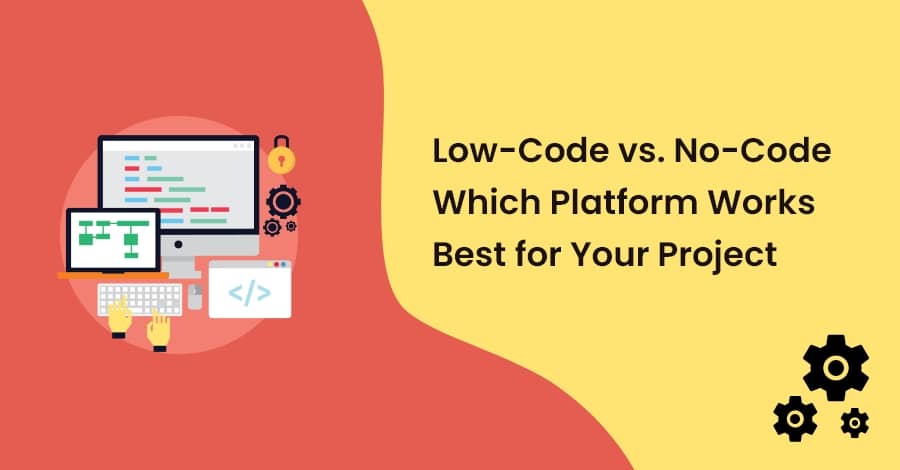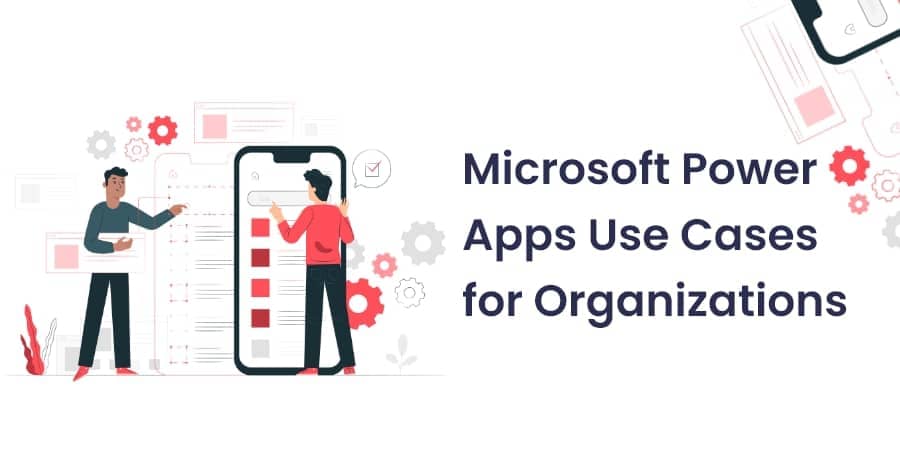
27 Oct Low-Code vs. No-Code: Choosing the Right Platform
27 October 2022

The concept of “no code” and “low code” development has rapidly gained popularity in recent years.
According to Gartner, by 2025, these approaches are expected to be utilized in around 70% of new applications created by businesses. No code and low code tools empower users to build applications without requiring traditional programming skills. They leverage visual interfaces, business terminology, and data connections, enabling business users to connect data sources, select fields, and effortlessly drag and drop tools to create powerful enterprise applications.
Even if you are unaware, if you are using the Microsoft Power Platform, you are likely already deeply involved in the low-code movement. PowerApps development specifically empowers business owners to deliver robust applications with minimal or no programming experience.
In this article, we are describe the difference and benefits of low code and no code development to help you determine which is the best option for your next project.
What is Low-Code Development?
Low-code software development methods use little or no coding to create processes and apps. In a minimal code development platform, you can use visual interfaces with simple logic and drag-and-drop features in place of complex programming languages.
What is No-Code Development?
No-code platforms, as their name suggests, don’t require any coding knowledge. It is a visual, drag-and-drop platform that enables plug and plays functionality. This implies that there is no learning curve required for anyone without IT experience to design usable apps.
Low Code vs No Code Platform Comparison Table
| Criteria | Low-Code | No-Code |
| Definition | Platform that enables developers to create applications with minimal coding effort | Platform that enables non-technical users to create applications without writing any code |
| Target User | Professional developers with coding knowledge | Citizen developers or business users without coding knowledge |
| Complexity | Higher complexity as some coding is still required | Lower complexity as no coding is required |
| Customization | More customizable due to coding abilities | Limited customization options |
| Speed | Faster development compared to traditional coding | Even faster development compared to Low-Code |
| Cost | Higher cost due to skilled developers required | Lower cost as no skilled developers required |
| Scalability | Scalable for complex applications | Limited scalability for complex applications |
| Maintenance | Requires ongoing maintenance and updates | Low maintenance requirements |
| Integration | Integrates with complex systems and databases | Limited integration options |
Difference Between Low code and No code development
Low-code development is a catch-all term for any approach that does not adhere strictly to the object-oriented paradigm. There are several variations on this concept, including microservice-based development, DevOps, and lean/agile development. They all have in common their prevalence among start-ups and smaller organizations. Low-code approaches are most often used when there is a need to quickly build out a product without investing heavily in infrastructure or tooling. This is typically due to tight budgets or constraints in terms of time and resources.
In contrast, no-code development is characterized by a stricter adherence to the object-oriented paradigm. Additionally, these approaches tend to be more concerned with writing code than they are with testing it or documenting it. In many cases, this means that code must be validated from start to finish before it can be deployed into production. This level of rigor is necessary to avoid introducing bugs into your system over time. One way to ensure your code is valid and reliable is by using automated tests that exercise your application’s functionalities in controlled environments.
Benefits of Low Code and No Code Development
Business agility
No-code and low-code development platform are extensible and provide direct integrations with major vendors, transforming APIs, web services, and command lines into reusable building blocks. This reduces the time required to integrate and deploy new tools and technologies, allowing organizations to respond to business and employee needs by developing customized apps as needed.
Cost savings
One of the most important benefits of low-code and no code development is enhanced cost savings. This is because such tools turn many of the complicated steps involved in creating an app into a straightforward drag-and-drop approach.
Expenses inevitably drop when more apps are created faster, but no-code and low-code development also reduces costs in other ways. This includes removing the need for external software purchases and increasing productivity.
Automate more in less time
Automation of tasks and end-to-end processes can be accelerated with No-code vs Low-code development. Workflows that start based on event triggers, templates that can be used to quickly develop new processes, and prebuilt integrations and API access that allow you to automate virtually any digital business process are all examples of this.
Improved efficiency
Utilizing no-code and low-code development platform also helps increase the overall effectiveness of your company. When utilizing conventional methods, development projects frequently take a very lengthy time to finish. Team members may become frustrated as a result, and some may even leave the group. Traditional development methods can often be quite resource-intensive. You can avoid these issues by using low-code and no-code platforms, which enable you to create apps rapidly and effectively. As a result, your team members are more content, and your company as a whole operates more effectively.
Low-code platforms, such as PowerApps, streamline all of this, making development hyper-efficient and a true value-add to your workflows.
Flexibility and scalability
Platforms for low code/no code development are also incredibly adaptable and scalable. As your company expands, you may quickly add additional features to your applications. These platforms are also ideal for companies of all sizes. Simple apps for small enterprises or huge enterprise applications for large organizations can both be created using them.
Resultant apps
Low-code vs No-code development platforms are great options for creating apps that improve business operations. No-code platforms are perfect for developing applications for minor business problems, while low-code platforms make it possible to create high-demand apps.
Requirement of training
No technical experience is required for no-code development platforms, however, low-code platforms have more complex tools and provide more customization – making them appropriate only for individuals with programming knowledge. Training may be necessary when it comes to low-code platforms.
Speed of development
Low code and no code development benefits developers to build applications faster than traditional coding methods. This is because these tools offer pre-built components and drag-and-drop interfaces, allowing developers to create applications quickly and easily. With low and no code development, developers don’t need to write every line of code from scratch, which saves a significant amount of time. As a result, they can focus more on building the logic of the application and the user interface rather than worrying about the underlying code, making the development process more efficient.
Increased productivity
With low code and no code development, developers can be more productive as they can create applications faster and more efficiently. They can reuse pre-built components and templates to build new applications quickly, reducing the time and effort required for development. This increased productivity allows developers to build more applications in less time, which can be beneficial for companies looking to launch applications quickly.
Need for Low Code and No Code
The need for both development is driven by the increasing demand for software applications in today’s digital business environment. These platforms allow organizations to quickly and easily create and deploy software applications without the need for extensive coding or programming experience.
Both platforms also allow organizations to reduce development costs and improve time-to-market for their software applications. By leveraging pre-built components and visual tools, these platforms enable faster development, testing, and deployment of software applications.
Additionally, low-code and no-code platforms can also enable citizen developers, who are employees with little to no programming experience, to create and customize software applications for their specific business needs. This can lead to increased innovation and efficiency within an organization.
Low-Code Development Benefits with the Power Platform
The Microsoft Power Platform, led by reliable PowerApps, includes its low-code vs no-code development tools as part of its strong, dynamic business structure. It is a quicker, more trustworthy, and more affordable approach to creating unique company solutions. It offers a wide variety of templates to help kick-start your project. You can also build your custom templates to create repetitive projects.
The Power Platform has a drag-and-drop interface that lets you quickly create your application. No matter how complex your project is, you’ll still be able to access it through an easy-to-use interface. You can get real-time insights from your application using the platform’s built-in analytics. You can also add your integrations for a more comprehensive look at your data. The Power Platform, which was built on Azure, is the world’s greatest platform for customer-focused development at the moment and is elastic, secure, and highly scalable.
By understanding the different benefits of low code and no code platforms but, still confuse about choosing one for your project. Star Knowledge has assisted numerous small and midsize businesses in utilizing the numerous advantages of Microsoft Power Platform, Azure, SharePoint, and Office 365. And we can’t wait to add your company to this prestigious list. Contact us today to see if we’re a good fit for you and your team.
Our Related Posts
Power Apps Use Cases
What are Power Apps? PowerApps is a powerful business tool that takes advantage of the cloud to provide you ….
Power Apps New Enhancements and Increased Capabilities
Every year, Power Apps comes with new ideas to tune the design and improve its AI model to make ideas work better….
Benefits of Power Apps Integration for your organization
What are Power Apps? Power apps are a new toolset for building great experiences that run on the…





Sorry, the comment form is closed at this time.